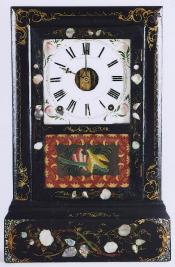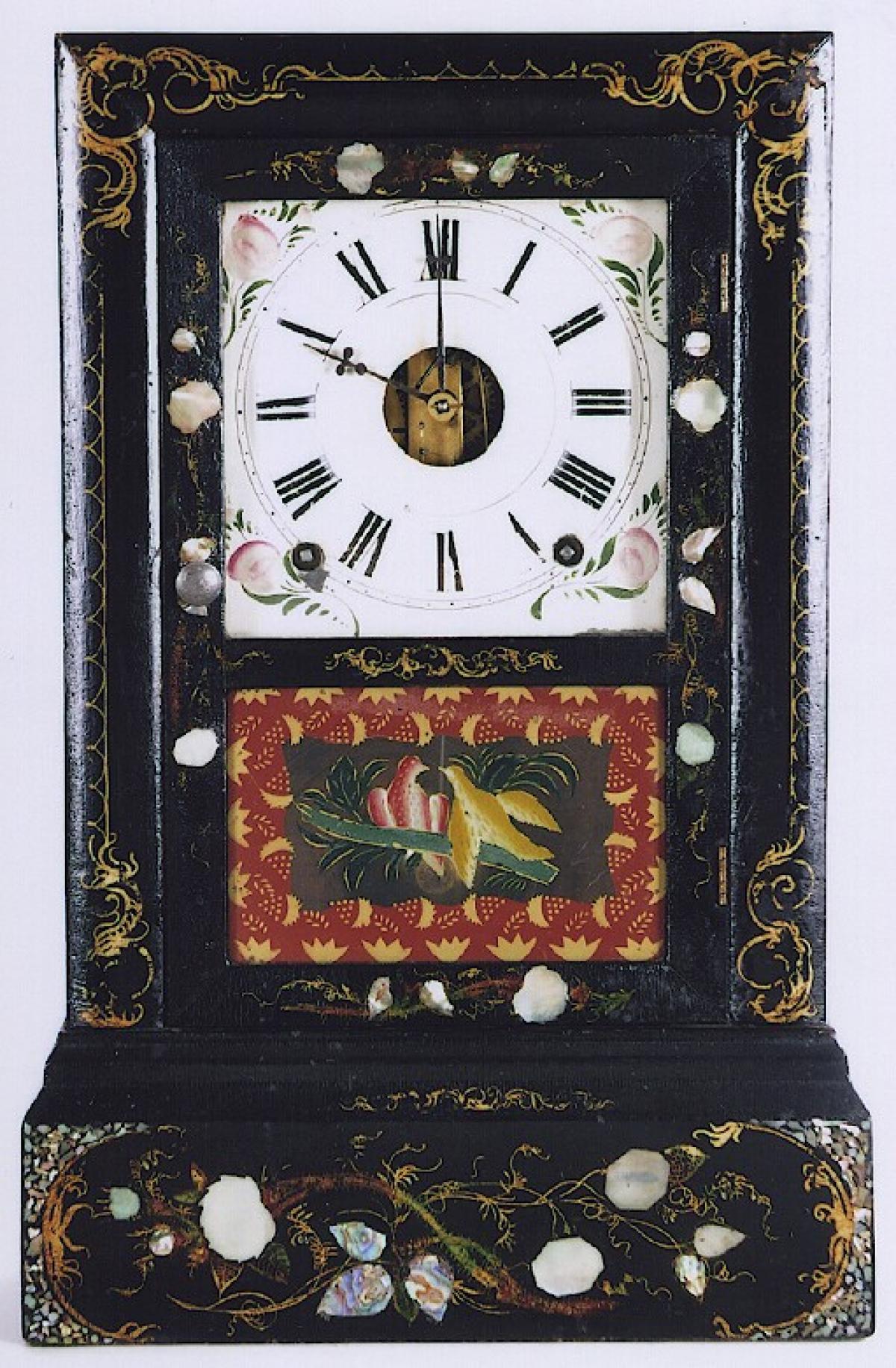Seth Thomas shelf clock. Plymouth Hollow, Conn. Decorated with mother of pearl. TT-152.
Wow. This Seth Thomas-made clock is in excellent original condition.
This mantel case form is constructed with a wooden case that has been painted black. The front surfaces are colorfully decorated with hand-painted gilt scrolling and inlaid mother-of-pearl. Mother-of-pearl consists of pieces of the iridescent inner layer of certain mollusk shells. These are shaved thin and applied to or embedded in, in this case, clock cases to create an Oriental appearance. This was used as a decorative detail in clock case construction in the mid-1800s' by several firms. It is unusual to find it in such a vibrant condition. In addition to this decoration, the dial, and the tablet are also colorfully decorated.
The tablet is painted from the back. It depicts two colorful birds sitting on a branch of a tree. Perhaps they are love birds? The broad border of this scene is predominately red and is a field of color for the gilt decorations.
The dial is painted on tin. The hours are represented in Roman-style numerals and are painted on a slightly raised band. The four spandrel areas are decorated with additional florals. The center aperture of this dial is intentionally left open. This allows the viewer to see that the movement in this clock is brass.
The brass time and strike movement is designed to run for eight days on a full wind. It is spring-driven. The plates are lyre-shaped, and the front plate is die-stamped by the Maker. The striking system is a countwheel design.
The original Clockmaker's Plymouth Hollow label is in good overall condition. It does have some areas of staining. It is applied to the backboard inside the case. This is an interesting label because it features a stagecoach at the bottom.
This very colorful model was made circa 1860. The case measures approximately 17 inches tall, 11 inches wide, and 4.75 inches deep.
Inventory number TT-152
Seth Thomas was born in Wolcott, Connecticut, in 1785. He was apprenticed as a carpenter and joiner and worked building houses and barns. He started in the clock business in 1807, working for clockmaker Eli Terry. Thomas formed a clock-making partnership in Plymouth, Connecticut, with Eli Terry and Silas Hoadley as Terry, Thomas & Hoadley. In 1810, he bought Terry's clock business, making tall clocks with wooden movements. Seth chose to sell his shares in the partnership in 1812, moving in 1813 to Plymouth Hollow, Connecticut, where he set up a factory to make metal-movement clocks. In 1817, he added shelf and mantel clocks. By the mid-1840s, He successfully transitioned to brass movements and expanded his operations by building a brass rolling mill and a cotton factory. In 1853, He incorporated the business but continued to be the majority shareholder. This clock business expanded until it became one of the "BIG Seven" in Connecticut. Their product line had offerings that competed at every price point, from kitchen clocks to precision regulators. Seth Thomas died in 1859. The community of Plymouth Hollow so revered him that they changed the name on July 6, 1875, to Thomaston in his honor. After his death, his son, Aaron, took over the company's leadership. Aaron is credited with increasing the business by adding a number of new case styles and improving production methods. The company went out of business in the 1980s.














